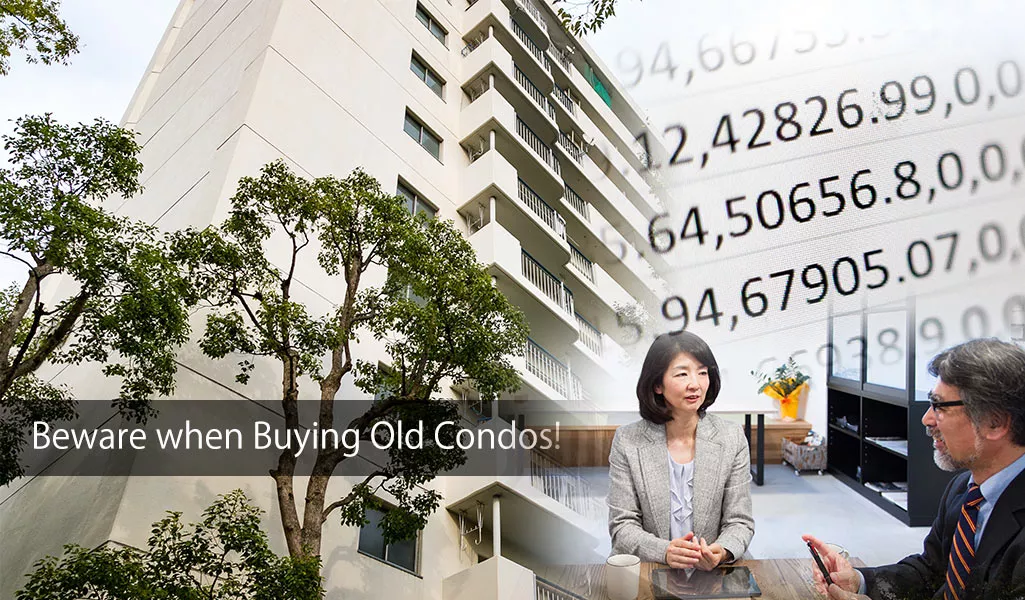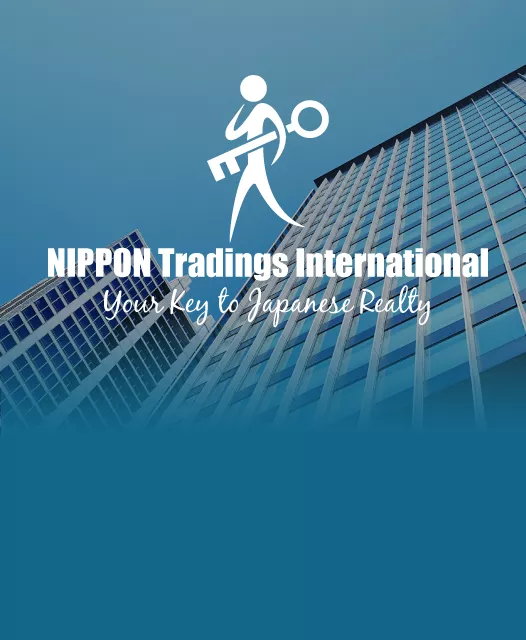Beware when Buying Old Condos!
The following article was written by Ziv Nakajima-Magen – Partner & Executive Manager, Asia-Pacific Nippon Tradings International (NTI)

The Attraction
Individual condominium units in co-owned buildings are the most popular asset class in Japan’s real-estate property investment market - particularly for smaller private investors – for the following reasons –
1. Affordability
Condo units, which come with a smaller land footprint (the building’s entire land footprint is distributed between the owners, proportionate to their units’ floorplan sizes), are usually the cheapest way to enter the market, and provide immediate turnkey profitability potential. The only cheaper asset type out there is rural land, with or without old, mostly abandoned houses built on it – but these types of properties rarely turn any profit upon purchase, and would require significant renovation and/or marketing work before they can be tenanted and start generating income - if at all.
Well located condo units, on the other hand, either generate income from the moment of purchase (if tenanted) or alternatively, can be easily tenanted, with perhaps only a relatively low extra investment required, for minor renovations or improvements.
2. Stability
The monthly contributions made by unit owners to the co-owned building’s reserve funds pool, as well as the monthly management fees, would generally cover most or all structural and common area maintenance expenses (including individual balconies). Although these fees tend to rise over time, as the building gets older and requires more regular maintenance and renovation – there are very few surprises in store for unit owners, who can generally rest assured that they will not be asked for any unexpected bulk payments for structural or common area maintenance and renovation. Both planned and unplanned repairs and renovations will normally be taken care of by the building management company, with the funds required for them taken out of these reserve funds pools.
One-off payments would only be required in cases where severe unexpected damage has occurred (such as in the case of a major earthquake or other natural disaster) – and even in those cases, if the reserve funds accumulated aren’t sufficient, the owners’ co-op would normally prefer to take out a loan for this purpose - and raise monthly fees to compensate over time - as opposed to charging unit owners a bulk fee for the repairs.
3. "Tenantability"
Condo units are the preferred living arrangement for singles, childless couples and small, granular families – and these tenant profiles compose the largest portion of the available tenant base in Japan, due to the country’s demographics and fast-declining/ageing population trend. Larger families, while they certainly do exist, are more rare – and would in any case normally prefer to take out a mortgage and purchase their own, larger condo or house, whenever possible.
As a result, smaller units (studios, 1-2 bedrooms) in popular residential areas of medium and large cities, rarely experience long vacancies – particularly if the building is well maintained – which, of course, helps to maintain a healthy and stable income stream.
4. Profitability
In Japan, and particularly in Japan’s medium and large cities, which are densely populated metropolitan centres located in a country which, topographically, consists mainly of mountainous ranges – space is a premium. Building upwards, in tall building format, even in suburban areas - as opposed to the sprawling house format more common in most Western countries – and small units floorspaces, utilising compact and versatile interior design, is the norm here – and larger floorspace properties come at a far higher price – a price which rises far more sharply than the achievable rent amounts for these larger units (rents also rise with the increase in space, but not nearly as sharply as the purchase price does).
As a result, condos with smaller floorplans - designed for the minimal living space which Japanese singles, couples and small families are used to - tend to generate far higher yields than larger condo units (which are considered luxurious in Japan) or houses.
The Age Factor
Another unique aspect of Japan’s property market, which is derived from the Japanese obsession with everything new and modern, means that buildings, and in particular smaller buildings that are not reinforced concrete based, are made of materials that are generally not built to last much beyond 3 decades. And so, it is very rare to see the typical Western brick or stone homes that can withstand the test of time, and/or constant battering of the elements over an extended period of time. As a result, older buildings, and particularly smaller, wood or steel-framed wood structures, tend to drop in price sharply during their life spans – and again, while rent achievable for these older builds also decreases with age, it doesn’t decrease nearly as sharply as the purchase price graph does – resulting in significantly higher rental yields for smaller, older condo units.
These smaller units can be purchased for as low as 20-30,000 USD, generating rental yields as high as 8-10% net pre-tax annually, in many attractive locations all around Japan.
The Danger Inherent in Cash-Cows
Due to all of the factors laid out above, the highest yielding and most predictable/stable asset class in Japan are smaller, older condo units in co-owned blocks – and as such, these tend to be very popular with investors – particularly private, smaller scale investors who are operating in this arena for the very first time, and are naturally looking for the highest possible yield (which makes sense, considering Japan’s lack of stable, long term capital growth since the early 1990's - a trend halted, albeit only partially, since late 2012).
However, there is one unique risk inherent in these “cash-cows”, which, while not insurmountable, should be taken into account before one pours their entire capital or savings into a large portfolio consisting only, or mostly, of this asset class – and this particular risk may not be obvious to many first time buyers – namely -
Shady Developers

While Japan, as a rule, is an honest and law-abiding society – there are rotten apples everywhere, and Japan is no exception. In the real-estate sector, these rotten apples are often found in the residential development area – and these firms would not hesitate to use any means at their disposal to “nab” an under-priced or under-evaluated asset, completely disregarding the norms – or even the laws, written and unwritten alike – of fair business negotiation and deal-making. And, considering the vast majority of individual unit owners are normally small-time investors, with far less experience, or even owners-occupiers, who have purchased a unit for their own use and have been living in it for decades – it is quite easy for these shady developers to use scare tactics and aggressive negotiation techniques, which would be considered unfair, immoral or outright illegal, in their quest to obtain the best possible land parcel, for the cheapest possible price - and politeness, kindness and consideration be damned.
In practice, this means that, as a building gets older and maintenance, renovation requirements and monthly fees start creeping upwards, these unscrupulous practitioners would often swoop in, and begin to apply pressure on owner co-ops to sell the building to them at a ridiculously low price. To achieve this, they’ll quote inaccurate figures and statistics meant to pressure the owners into selling, under the stated threat of potential loss if they refuse or try to postpone the sale. This tactic involves such things as equating a building’s tax depreciation life-span with its actual life-span - two evaluation methods that often have nothing to do with each other, since buildings, and in particular reinforced concrete buildings, can be practically and profitably renovated and brought up to speed with current liveable and rentable standards, far beyond their official tax depreciation life-span of 47 years – maintaining their market value, or even increasing it, if land prices have gone up significantly over a period of a few years.
Since a majority of 80% agreement is all that is required for major decisions such as selling a building, it is possible for these developers to often convince enough of the individual unit owners to sell the building to them – and even though the remaining 20% would still be officially and legally in possession of their individual units - all common areas, utilities and facilities in the building would now belong to the developer, who, in most cases, is seeking to demolish the property and re-build, or otherwise re-purpose the attractive land parcel. As the sole owner of the building’s common facilities, the new owners of the structure are now at liberty to stop the provision of power, water and structural maintenance and repairs to those unit owners, rendering their units unliveable and unrentable in the process. They can also increase monthly fees to those unit owners at the same time, until these owners are no longer able to financially hold on to their properties, and are then forced to forego them, or to finally agree to sell them to the developer, at an even lower price than that which was originally offered.
To achieve this 80% agreement, some of these shady operators will resort to illegal means such as lying (telling unit owners they contact that agreement is already very close to 80%, and threatening them with being the only remaining unit owners in the building in a matter of weeks), as well to bribing owner co-op representatives, promising them increased compensation upon sale of the building, and otherwise coercing them into exerting pressure on other unit owners, until they reach their 80% agreement goal.
A more straight forward tactic which often helps the developers achieve this goal - and this one is often practiced by even the less corrupt among them - is to first purchase a small percentage of the units in the building from some of the owners, at average market prices – which then provides them with entry and participation in owner co-op meetings, as well as voting rights on any owner co-op decisions – which of course further helps to increase their chances of achieving the necessary agreement, when the time comes to put their end-game plan into action, and attempt to achieve agreement to sell the entire structure, a year or two down the track.
In this way, owners are often pressured and convinced to sell buildings which, while older, may be completely profitable, maintainable and attractive for tenants, at an extremely low price – and, while some investors may have purchased their units a decade or two prior to this sale, and have profited enough from their rental income streams to still be well in the green – others, and especially those who have purchased their units when the building was already 35-45 years old, may find that this happens soon after their purchase, and that they haven’t yet accrued enough profits from their unit to make their bottom line attractive enough – but are still forced to sell regardless – even though they should have been able to extract at least another decade of profitable rental income from their properties.
Mitigating the Risk

All of the above is not meant to scare potential investors off these older cash-cow condo units, not by any means – as they CAN BE profitable and worthy investments - but simply to point out that the risk does exist, and that one would do well to be aware of it prior to pulling the trigger on any particular purchase.
Specifically, would-be investors would do well to implement one or more of the following strategies –
1) Stick to buildings that are no older than 35 years at the time of purchase (which would normally provide owners with at least a decade of stable rental income before anyone considers buying or selling it).
2) When purchasing units in older buildings, try to stick to the huge reinforced concrete monsters, located in extremely attractive locations – buildings with 100-200 units, which are always in demand, cost far more for developers to demolish and dispose of – and also take the total compensation payable to existing unit owners to a far higher level – which in turn makes the capital outlay and efforts involved in the exercise not worth it for most smaller developers. The only ones interested in these projects tend to be the few nationally acclaimed mega-developers, who are under constant scrutiny and tend to be less dubious in their purchase tactics.
3) Review the building’s renovation history carefully, to make sure the building management company appointed by the owners’ co-op has been doing a good, or at least a reasonable job, in keeping the building liveable and profitable over the past decade or so – as unit owners who are turning a neat profit and are satisfied with the performance of their property are far less likely to be easily convinced to sell.
4) Naturally, the best risk mitigation strategy, if you can afford it, is to simply purchase and own the entire structure yourself – in which case you'd be the only one “calling the shots” on all potential purchase offers down the track. And with Japan offering a multitude of smaller, well located and profitable condo blocks for as low as 30 mil JPY (less than 300,000 USD) – there are plenty of options available – AND, you’ll enjoy the added value of having the flexibility to do as you wish with your property, and not be subject to owner co-op regulations and bylaws - regulations which normally prohibit commercial or storage purpose rentals, short term rentals such as monthly leases or AirBnb type guest accommodation, and so forth. Additionally, if and when the building DOES become less profitable, you’ll always have the option to demolish and dispose of it yourself (not too expensive for wooden or steel-framed wood structures), then re-purpose the land parcel for more creative and cost-efficient uses, even if you’re short on capital - such as constructing warehouses and other logistics facilities (an asset class that is in very high demand with today’s e-commerce oriented culture), or even parking lots (which are very low on maintenance and upkeep, and can be very profitable if several stories high and in high-demand metropolitan areas).
All of the suggestions above are of course part and parcel of any purchase consideration and due diligence, in any country and regarding any asset class you may be considering for purchase – but are doubly important – perhaps even crucial – when considering a purchase of individual units in co-owned buildings.
















